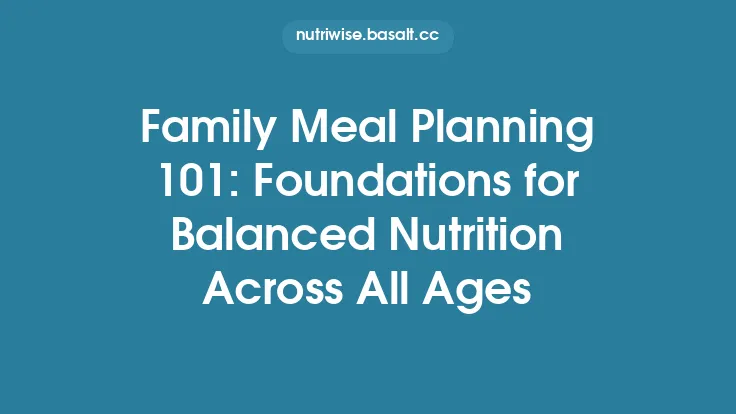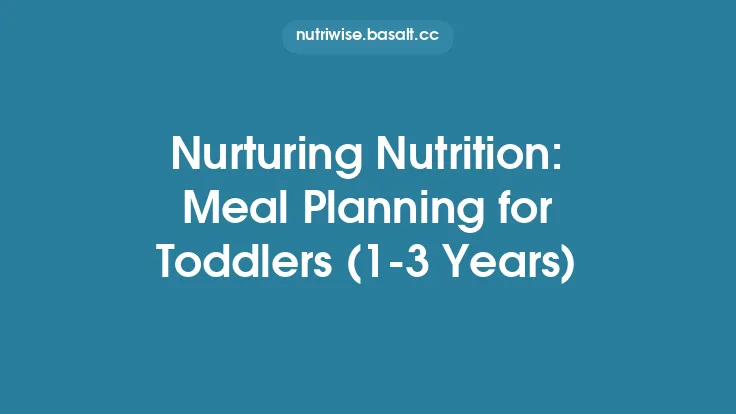Portion control is one of the most powerful, yet often overlooked, tools families can use to nurture lifelong healthy eating habits. While the quality of foods matters, the amount served at each meal plays an equally critical role in shaping energy balance, supporting growth, and preventing chronic disease. By establishing clear, evidence‑based guidelines for portion sizes, parents can create a kitchen environment where children learn to listen to their bodies, adults maintain a healthy weight, and the entire household enjoys meals that satisfy both hunger and nutritional needs.
Why Portion Size Matters Across the Lifespan
Energy balance and weight management
The human body regulates weight through a delicate interplay between calories consumed and calories expended. When portion sizes consistently exceed energy needs, excess calories are stored as fat, increasing the risk of overweight and obesity. Conversely, portions that are too small can lead to nutrient deficiencies, especially in growing children and active adults.
Growth and development in children
Children’s caloric and nutrient requirements change rapidly during infancy, childhood, and adolescence. Providing age‑appropriate portions ensures they receive sufficient protein for muscle development, calcium for bone growth, and essential micronutrients for cognitive function. Over‑portioning can blunt appetite regulation, making it harder for children to recognize internal hunger cues later in life.
Metabolic programming
Research indicates that early exposure to appropriate portion sizes can “program” metabolic pathways, influencing how the body processes fats and sugars decades later. Establishing sensible portion norms during family meals therefore contributes to long‑term health outcomes such as reduced risk of type 2 diabetes, cardiovascular disease, and certain cancers.
Core Principles for Determining Portion Sizes
- Reference to Energy Needs
- Adults: Average daily energy requirements range from 1,800 kcal (sedentary women) to 2,800 kcal (active men). Portion sizes should be calibrated to meet roughly 20‑30 % of daily calories per main meal, with the remainder distributed across snacks and beverages.
- Children: Use age‑specific Estimated Energy Requirements (EER). For example, a 4‑year‑old typically needs 1,200–1,400 kcal/day, while a 12‑year‑old may require 1,800–2,200 kcal/day, depending on activity level.
- Macronutrient Distribution
- Protein: 15‑20 % of total calories. A standard adult portion is 3‑4 oz (≈85‑115 g) of cooked lean meat, poultry, fish, or plant‑based equivalents. For children, 1‑2 oz (≈30‑55 g) is appropriate, scaling with age and size.
- Carbohydrates: 45‑55 % of calories, emphasizing complex carbs. One serving of cooked whole grains or starchy vegetables is roughly ½ cup (≈80 g). Children’s servings are typically ¼‑⅓ cup.
- Fats: 25‑35 % of calories, focusing on unsaturated sources. One tablespoon (≈14 g) of oil or nut butter counts as a serving. For kids, ½‑1 tsp is sufficient.
- Energy Density Considerations
Foods with high water and fiber content (e.g., soups, salads, fruits) have low energy density, allowing larger volumes without excess calories. Incorporating these foods can naturally moderate overall portion size while promoting satiety.
- Visual Portion Guides
- Hand Method:
- Palm = protein (≈3‑4 oz for adults)
- Fist = vegetables (≈½‑1 cup)
- Cupped hand = carbs (≈½ cup)
- Thumb = fats (≈1 tsp)
- Plate Method: Fill half the plate with non‑starchy vegetables, one‑quarter with protein, and one‑quarter with whole‑grain or starchy carbohydrate. This visual cue aligns with USDA MyPlate recommendations while emphasizing portion control.
Age‑Specific Portion Guidelines
| Age Group | Protein | Vegetables | Whole‑Grain/Starch | Healthy Fats |
|---|---|---|---|---|
| Infants (6‑12 mo) | 1‑2 oz pureed meat or ¼ cup beans | ¼‑½ cup pureed veg | ¼ cup iron‑fortified cereal | ½ tsp butter or oil |
| Toddlers (1‑3 yr) | 1‑2 oz meat/fish or ¼ cup legumes | ½‑¾ cup cooked veg | ¼‑½ cup cooked grains | ½‑1 tsp oil or nut butter |
| Preschool (4‑5 yr) | 2‑3 oz protein | ¾‑1 cup veg | ½ cup grains | 1 tsp oil |
| School‑age (6‑12 yr) | 3‑4 oz protein | 1‑1½ cup veg | ½‑¾ cup grains | 1‑2 tsp oil |
| Adolescents (13‑18 yr) | 4‑5 oz protein (more for active teens) | 1½‑2 cup veg | ¾‑1 cup grains | 2‑3 tsp oil |
| Adults | 3‑4 oz protein | 1‑2 cup veg | ½‑1 cup grains | 1‑2 tsp oil |
*These values are averages; individual needs may vary based on growth velocity, activity level, and health status.*
Practical Tools for Measuring and Controlling Portions
- Kitchen Scales: Weighing protein and carbohydrate portions provides the most accurate data, especially useful for meal prep and when introducing new foods.
- Measuring Cups & Spoons: Ideal for grains, legumes, and fats. A ½‑cup measure is a quick reference for a standard carbohydrate serving.
- Portion-Control Plates: Divided into sections that correspond to the plate method, helping family members self‑serve appropriate amounts.
- Digital Apps: Many nutrition tracking apps allow users to log meals with visual portion cues, reinforcing learning over time.
- Pre‑Portioned Containers: Store leftovers in single‑serve containers (e.g., 4‑oz for protein, ½‑cup for veggies) to simplify reheating and reduce the temptation to over‑serve.
Strategies to Implement Portion Guidelines at Family Meals
- Serve from the Kitchen, Not the Table
Plating individual portions before guests sit down prevents “family‑style” over‑serving. Use the visual guides above to portion each plate.
- Use Smaller Dishware
A 9‑inch plate appears fuller than a 12‑inch plate when filled with the same amount of food, subtly encouraging smaller portions.
- Offer a “First‑Help” Portion
Serve a modest initial portion and invite seconds only after a brief pause. This pause allows satiety signals to emerge, reducing the likelihood of overeating.
- Separate High‑Calorie Condiments
Place sauces, dressings, and gravies in small bowls rather than drizzling them directly onto food. This gives diners control over how much they add.
- Model Mindful Eating
While mindful eating is a separate topic, simply pausing between bites and chewing thoroughly can help everyone recognize fullness cues without formal “mindful eating” instruction.
- Educate Through Conversation
Explain why a particular portion size is chosen (e.g., “Your body needs this much protein to grow strong”). Framing portions as a health tool rather than a restriction fosters cooperation.
Adjusting Portions for Activity Level and Special Situations
- Highly Active Children and Teens
Increase protein and carbohydrate portions by 25‑50 % on days with intense sports or physical education. Ensure extra calories come from nutrient‑dense sources (e.g., lean meats, whole grains, fruits) rather than sugary snacks.
- Pregnant or Lactating Women
Add roughly 300‑500 kcal per day, translating to an extra ½‑1 cup of whole grains and an additional 1‑2 oz of protein per meal.
- Medical Conditions
For families managing diabetes, hypertension, or lipid disorders, portion sizes of carbohydrates and fats may need tighter control. Consult a registered dietitian for individualized adjustments.
- Growth Spurts
During rapid growth phases (e.g., early adolescence), children may naturally increase their appetite. Offer slightly larger portions temporarily, monitoring weight trends to avoid excess.
Monitoring and Fine‑Tuning Portion Practices
- Regular Growth Checks
Track children’s height, weight, and BMI percentile at routine pediatric visits. Sudden upward shifts may signal over‑portioning.
- Food Diaries
Keep a simple log of meals and portion sizes for a week each month. Review patterns and adjust as needed.
- Satiety Rating Scale
After meals, ask family members to rate fullness on a 1‑5 scale (1 = still hungry, 5 = completely satisfied). Consistently high scores (≥4) may indicate portions are too large.
- Portion Audits
Once per quarter, compare actual serving sizes (using a scale) to the guideline chart. Small discrepancies can be corrected before they become habits.
Common Pitfalls and How to Avoid Them
| Pitfall | Why It Happens | Solution |
|---|---|---|
| “All‑You‑Can‑Eat” Buffets at Home | Unlimited access encourages over‑serving. | Pre‑plate meals; limit serving dishes to one per food group. |
| Relying on “Eye‑Ball” Estimates | Visual perception is inaccurate, especially with dense foods. | Use measuring tools or portion‑control plates until the eye‑ball method becomes reliable. |
| Children “Cleaning the Plate” | Cultural or parental pressure to finish food. | Encourage listening to internal hunger cues; allow leftovers to be saved. |
| Over‑Portioning High‑Calorie Sides | Sauces, cheese, and fried items are easy to over‑serve. | Serve these items in separate small bowls; limit to 1‑2 tsp per person. |
| Inconsistent Portion Sizes Across Meals | Lack of a standard reference. | Adopt a single visual guide (hand or plate method) for all meals. |
Building Lifelong Healthy Habits Through Portion Awareness
When children grow up seeing portion control as a normal, non‑punitive part of eating, they internalize a set of intuitive skills:
- Self‑Regulation: Ability to stop eating when comfortably full.
- Nutrient Literacy: Understanding that “more” does not always mean “better.”
- Portion Flexibility: Adjusting intake based on activity, mood, and health status.
These competencies translate into adulthood, where individuals are better equipped to navigate restaurant portions, packaged food labels, and social eating situations without relying on external diet rules.
Quick Reference Cheat Sheet for the Whole Family
- Hand Guide:
- Palm = protein (≈3‑4 oz)
- Fist = veggies (½‑1 cup)
- Cupped hand = carbs (½ cup)
- Thumb = fats (1 tsp)
- Plate Layout:
- ½ plate = colorful non‑starchy vegetables
- ¼ plate = lean protein or plant‑based protein
- ¼ plate = whole‑grain or starchy carb
- Portion Sizes by Age (protein example):
- Toddler: 1‑2 oz
- Preschool: 2‑3 oz
- School‑age: 3‑4 oz
- Teen/Adult: 3‑5 oz
- Tools to Keep Handy:
- Small measuring cups (¼, ½)
- Digital kitchen scale
- Portion‑control plates or divided trays
- Check‑In Prompt: After each meal, ask, “Do you feel comfortably full, still a little hungry, or overly stuffed?” Use the answer to tweak the next serving.
By integrating these evidence‑based portion‑size guidelines into everyday family meals, households can create a sustainable foundation for healthy eating that endures from childhood through adulthood. The focus shifts from restrictive dieting to empowering each family member with the knowledge and tools to nourish their bodies appropriately—one well‑measured plate at a time.





